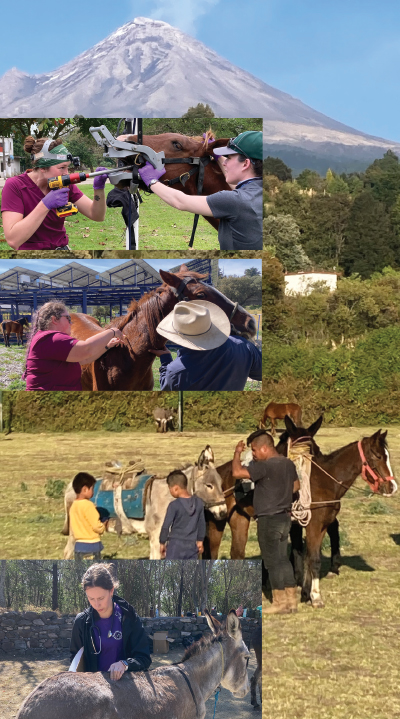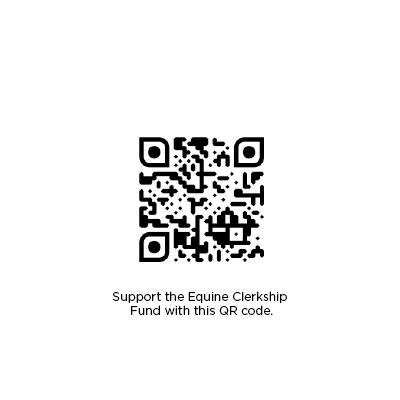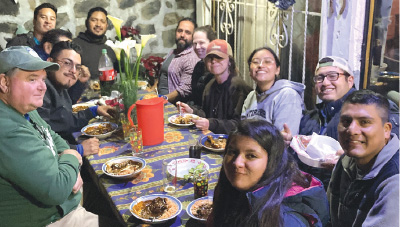

Waking to the call of howler monkeys, setting up surgery, dental, and farrier stations in a soccer field, and watching equine patients line up for treatment is just a small part of the Equine Welfare in Practice Clerkship.
Students from the MSU College of Veterinary Medicine who participate in the clerkship fly to Mexico in January and stay for two weeks, traveling from community to community in a van and stopping in rural areas to treat equids. In 2025, they treated 855 equids over the course of their stay.
While some communities have access to a farrier or a visiting veterinarian in the area, others are so remote that they rely solely on annual visits from the clerkship group for their veterinary care.
“Equids in this community start working at a young age: horses begin at two years old, while burros and mules start working at one and a half years,” says Hannah Williams about La Palma, Veracruz, Mexico. Williams is a DVM student from the class of 2025 who participated in the clerkship this year.
“These animals work year-round, with horses working around 5 hours a day, 7 days a week, while burros and mules work about 3 hours a day, 7 days a week. Their working life spans 12 years or longer. When equids fall ill or become lame, owners take on the responsibility of caring for them in the absence of veterinary services.”
The clerkship serves as an opportunity for students from MSU and Universidad Nacional Autónoma de México (UNAM), and Universidad Veracruzana (UV) to get experience treating equids while rendering free, vital services to Mexican communities that rely on working horses, burros, and mules for their livelihoods.
“The number of cases we see each day during the clerkship is often much higher than what students would see at MSU or at an externship at an equine hospital in the States,” explains Dr. Hal Schott, professor of large animal clinical sciences at MSU and instructor for the clerkship. “Over the course of the clerkship, students’ confidence with common procedures like dental floats, castrations, and hoof trims increases exponentially. It is truly rewarding to watch each group of students grow into equine professionals year after year.”
The program has been running since 2017, and thanks to the collaboration between MSU, UNAM, and UV, this clerkship is responsible for treating 5,000 equids in total.
This year, the most common treatments tallied up to 56 castrations, 86 hoof trims, and a whopping 126 dental floats performed by students and faculty from the participating universities.
But it’s not all horse-work without some horseplay—students sightsee at Aztec ruins in Mexico City, explore the UNAM Los Tuxtlas Rainforest Biosphere Reserve, walk along Veracruz’s beaches, and feast on tamales often cooked by the communities they served.


“While working in this serene, rural town, there was this sense of calmness that was hard to come by in the bustling city. It was a great reminder of the important connection between animals and the land they live on—and the different pace of life in places like Magdalena Petlacalco,” says Amanda Norman, a clerkship participant from the class of 2025.
Interacting with the owners of the equids as they work, students are able to appreciate the importance of treating these animals, which are tied so intimately to the well-being of these communities, and the rewarding impact of their veterinary services.
“It’s not just about routine veterinary work—it’s about connecting with the community and making an impact on the lives of both the equids and their owners,” says Mariela Aponte-Hernandez, a DVM affiliate student who joined the College from Ross University to participate in clerkships.
“The equids in the communities we are working in are so much more than just livestock—they’re a testament to the hard work and traditions that sustain the communities. Whether they’re hauling goods, herding cattle, or carrying people across the land, these equids remain at the heart of rural life, working year after year to support both their owners and the wider community,” adds Williams.
The benefits are mutual. The hands-on clinical experience with hundreds of equids transforms those who participate from equine veterinary students to clear-eyed, steady-handed practitioners.
As Rachel Clewley, a student from the DVM class of 2025 puts it, “We now consider ourselves pros and are eager to continue putting our equine skills to
the test!”
